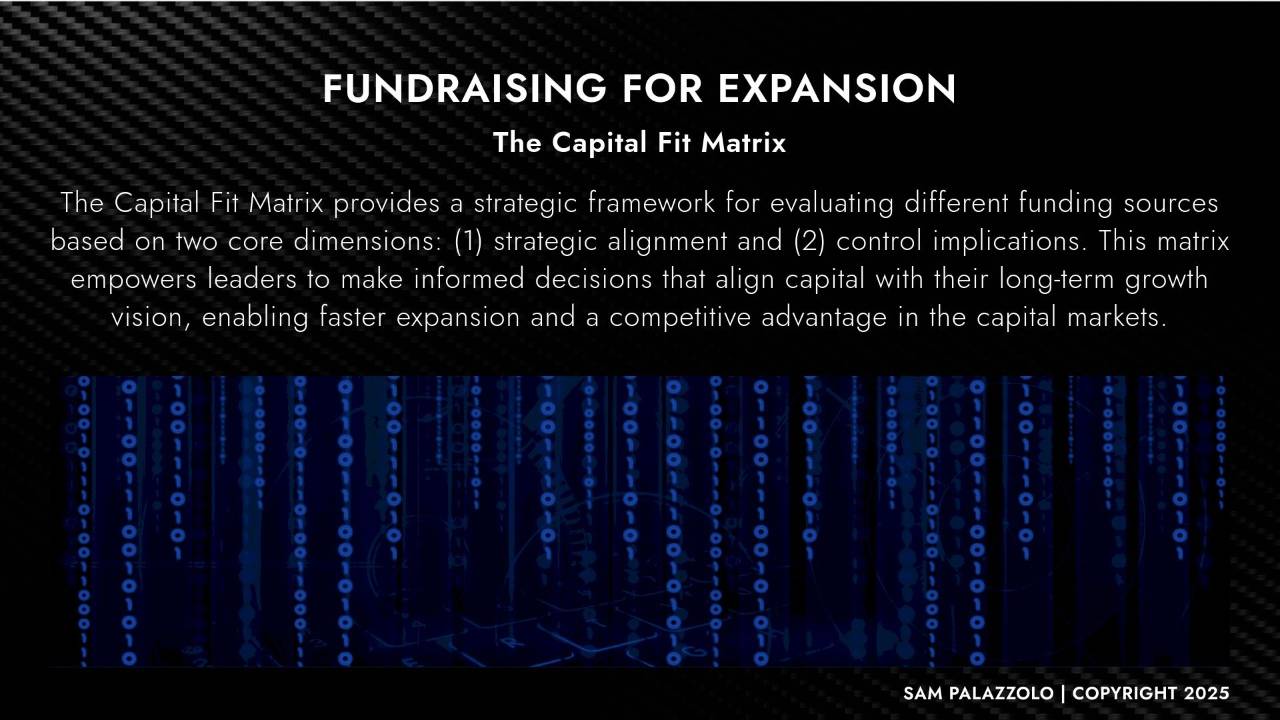Fundraising for Expansion: Aligning Capital with Growth Strategy
Apr 12, 2025
As organizations scale, the need for external capital often becomes inevitable. Whether it’s for hiring, entering new markets, investing in technology, or fueling M&A activity, securing the right kind of funding at the right time can determine whether a business accelerates—or stalls. And yet, many leaders approach fundraising with a reactive mindset, choosing whatever capital is most accessible rather than what is strategically aligned. That approach is not just risky—it’s counterproductive. The difference between sustainable expansion and growth derailment often lies in how well capital is aligned to the business’s long-term objectives.
The Fundraising Landscape: High Stakes, Low Success Rates
Let’s begin with a few sobering facts:
- Only 1% of companies that seek venture capital ever receive it.
- 80% of startups cite cash flow issues or failed fundraising as the reason for shutting down.
- Organizations that align their funding strategy with broader business goals grow up to 3x faster, according to Bain & Company.
These statistics reveal a dual challenge: not only is capital difficult to obtain, but selecting the wrong capital source can erode value, delay momentum, and introduce structural inefficiencies.
The Capital Fit Matrix: A Strategic Framework for Fundraising
To navigate this complex landscape, we introduce the Capital Fit Matrix—a simple yet powerful tool for aligning funding decisions with strategic intent. Based on the foundational principles outlined by William A. Sahlman in Harvard Business Review, this framework evaluates capital options along two critical dimensions:
- Strategic Alignment – How well does the funding source support the business’s growth stage, market position, and operational model?
- Control Implications – What is the impact on ownership, governance, and long-term decision-making autonomy?
By mapping funding sources across these dimensions, leaders can make more informed, context-sensitive decisions. Here’s a simplified view:
| Funding Source | Strategic Fit | Dilution / Control |
|---|---|---|
| Venture Capital | High | High |
| Private Equity | Med–High | Medium |
| Debt Financing | Low–Med | Low |
| Revenue-Based Financing | Medium | Low–Med |
| Strategic Investors | High | Medium |
Each funding path presents a distinct risk-reward profile. For instance, venture capital offers acceleration and credibility but at the cost of dilution and board oversight. Debt preserves ownership but requires consistent cash flows. Strategic investors can provide operational synergies, though alignment of interests must be carefully managed.
Common Pitfalls in Fundraising Strategy
Many businesses fall into predictable traps during fundraising:
- Misalignment of Capital and Strategy: Leaders may default to popular financing methods rather than those tailored to their growth model, resulting in pressure to deliver outcomes misaligned with internal capabilities.
- Overreliance on a Single Source: Enterprises that depend solely on one funding type—be it debt, VC, or internal reinvestment—risk inflexibility and exposure during downturns or operational disruptions.
- Failure to Anticipate Trade-Offs: Too often, the long-term implications of funding are overlooked. What seems like a quick win (e.g., early-stage VC) can result in downstream challenges—such as lack of control, misaligned board interests, or inability to pivot.
Real-World Application: Choosing Fit Over Familiarity
Consider the example of a mid-sized software company approaching $10M in annual recurring revenue. Eager to expand into Europe, the CEO was set on raising a $20M Series B round from venture capitalists. But after applying the Capital Fit Matrix, the executive team reconsidered. The firm already had strong cash flows, a sticky customer base, and low burn.
Instead of pursuing VC capital (which would have demanded aggressive growth and diluted the founding team), they opted for a hybrid solution: a mix of revenue-based financing and a strategic investment from a global systems integrator. This preserved majority control, unlocked new distribution channels, and kept expectations aligned with their pacing.
Twelve months later, the company had expanded across four markets—without giving up board seats or compromising on long-term goals.
Building a Funding Strategy That Scales
To build a high-leverage fundraising strategy, leaders should:
- Clarify Growth Objectives: Is the goal rapid expansion, margin preservation, product innovation, or operational scaling? The right capital must fuel the right goal.
- Assess Internal Readiness: Ensure that financial models, use-of-funds roadmaps, and investor-facing materials clearly articulate the return case.
- Evaluate Options Proactively: Avoid waiting until capital is urgently needed. Capital raises are best executed from a position of strength.
- Use the Matrix as a Decision Filter: Plot out funding options and vet them across strategic alignment and control dimensions before engaging investors.
Closing Thoughts: Aligning Funding and Vision
Fundraising is not a tactical checkbox. It’s a strategic inflection point. Leaders who recognize this—and act accordingly—gain more than capital. They gain clarity, control, and momentum.
By applying the Capital Fit Matrix and focusing on strategic alignment, leaders set themselves up not just for financial success, but for scalable, sustainable business growth.
Sam Palazzolo, Principal Officer @ The Javelin Institute
Subscribe to My Business Scaling Newsletter
Want insights like this delivered weekly? Subscribe now at https://sampalazzolo.com and receive my ‘50 Scaling Strategies’ guide (a $50 value) free with sign-up.
KEY TAKEAWAYS
- Only 1% of companies secure VC funding; 80% fail due to poor fundraising strategy.
- Misalignment of funding and strategy leads to excessive dilution or missteps.
- The Capital Fit Matrix helps evaluate funding options by Strategic Fit and Control.
- Leaders often pursue popular funding paths instead of purpose-fit capital.
- Real-world example shows hybrid capital preserving ownership and driving growth.
- Proactive fundraising—before it’s urgent—leads to better valuation and terms.
- The right capital partner should fit the vision, not force a new one.
SUBSCRIBE FOR WEEKLY BUSINESS SCALING STRATEGIES
REAL STRATEGIES. REAL SOLUTIONS.
We respect your privacy. Unsubscribe at any time.
